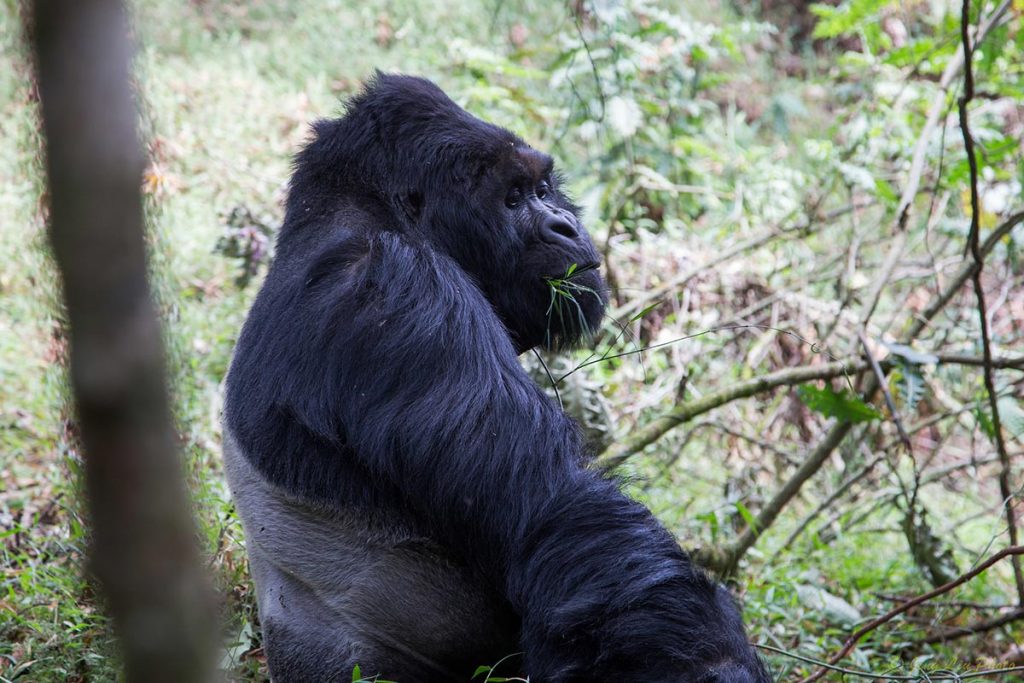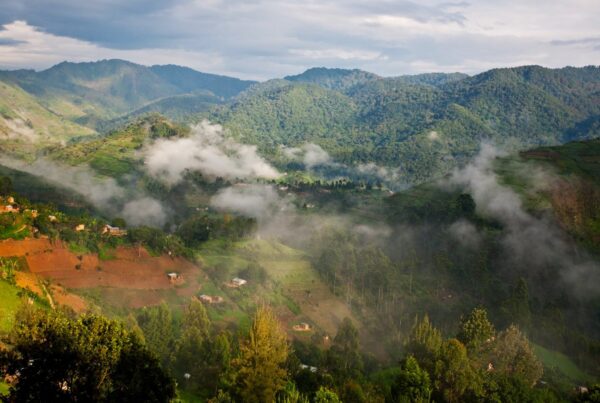Silverback Gorilla Trekking in Mgahinga
Into the Realm of the Mountain Giants
High in the mist-covered mountains of southwestern Uganda, where volcanic peaks rise dramatically against the sky and ancient forests whisper secrets of time immemorial, a rare and extraordinary experience unfolds. It is here, in Mgahinga Gorilla National Park, that the world of the silverback gorilla reveals itself to those willing to journey into its domain. Trekking in this landscape is not simply an activity; it is a profound communion with the wild, a passage through rugged terrain that leads to an intimate encounter with one of nature’s most awe-inspiring creatures.
Unlike any other safari experience, silverback gorilla trekking in Mgahinga is defined not by observation from a distance but by proximity that stirs the soul. The moment when the dense undergrowth parts to reveal the powerful figure of a silverback gorilla is a moment of silence, reverence, and recognition. It is a meeting between species that transcends the ordinary, an exchange of presence that leaves an indelible mark upon the heart.
The journey to this encounter demands patience, endurance, and respect. Yet it rewards with memories beyond measure: the sight of a silverback guiding his family, the playful innocence of young gorillas, and the quiet dignity of a landscape that has nurtured life for millennia. Mgahinga, though Uganda’s smallest national park, holds within it an experience vast in meaning, one that resonates far beyond the forest itself.
Mgahinga Gorilla National Park: The Crown of the Virungas
Mgahinga Gorilla National Park, though covering only 33.7 square kilometers, is part of the great Virunga Conservation Area, a chain of volcanoes stretching across Uganda, Rwanda, and the Democratic Republic of Congo. Its landscape is dominated by three extinct volcanoes—Mount Muhabura, Mount Gahinga, and Mount Sabyinyo—each rising in grandeur, their slopes cloaked in vegetation that shifts dramatically with altitude.
The park’s habitats are as diverse as they are breathtaking. At the lower elevations, montane forests thrive, giving way to bamboo groves where gorillas often feed. Higher still, the Afro-alpine moorlands spread like carpets across the upper slopes, dotted with giant lobelias and everlasting flowers. This variety of ecosystems supports not only gorillas but also golden monkeys, forest elephants, and an astonishing array of bird species, making Mgahinga a jewel of biodiversity.
The park holds cultural significance as well. It is home to the Batwa people, an indigenous group who once lived as forest dwellers and hunters. Their connection to the land remains a vital part of Mgahinga’s identity, offering visitors a glimpse into a way of life shaped by centuries of coexistence with the forest. Thus, trekking in Mgahinga is never solely about wildlife; it is also an immersion into a cultural and natural tapestry that few places on earth can match.
The Silverback Gorilla: Guardian and Leader of the Highlands
The silverback gorilla is more than a symbol of wilderness. He is the heart of his family and the guardian of the highland forests. His name derives from the distinctive silver-gray saddle of hair that appears on his back as he matures, usually around the age of twelve. Beyond his striking appearance, the silverback embodies strength, leadership, and deep familial responsibility.
Weighing up to 180 kilograms, with immense muscular power, the silverback is an imposing presence. Yet his role is not defined by aggression but by protection and guidance. He decides when the group travels, where they forage, and how they respond to potential threats. His leadership is rooted in authority tempered by care, ensuring the safety of mothers, juveniles, and infants under his watch.
The duality of the silverback’s nature is striking. He can unleash thunderous displays—beating his chest, vocalizing with power, and charging to deter intruders. Yet he can also be seen gently cradling infants, allowing them to climb upon him, or tolerating the playful antics of adolescents. This balance of might and tenderness is what makes the silverback a figure of profound reverence.
For those fortunate enough to trek in Mgahinga, the encounter with the silverback is transformative. His gaze, steady and unflinching, carries recognition that feels deeply human, bridging the divide between species. It is in this gaze that many visitors describe a sense of kinship, a realization of shared ancestry and mutual vulnerability.
Preparing for the Trek: Anticipation and Readiness
The journey to meet the silverback begins long before the forest is entered. A gorilla trekking permit, issued by the Uganda Wildlife Authority, must be secured in advance. The limited number of permits ensures minimal disturbance to the gorillas and underscores the park’s commitment to conservation.
On the morning of the trek, visitors assemble at the park headquarters, where trained rangers provide a thorough briefing. Guidelines are emphasized: the minimum distance to maintain, the limited one-hour viewing period, and the necessity of avoiding direct eye contact or sudden movements. Health precautions are vital, as gorillas are highly susceptible to human-borne illnesses.
Physical readiness is essential. The trails are steep, often muddy, and sometimes tangled with vegetation. Altitude adds to the challenge, with elevations ranging from 2,227 to over 4,000 meters. Porters are available, and their assistance not only eases the trek but also contributes directly to local livelihoods.
Beyond physical preparation lies emotional readiness. The anticipation builds with every step into the forest, each rustle of bamboo or distant call of a bird intensifying the sense of entering another world. The trek is not simply about reaching the gorillas but about surrendering to the rhythm of the forest, allowing it to guide, challenge, and prepare the heart for the encounter to come.
The Trekking Experience: Steps Toward the Silverback
The trek itself unfolds like a narrative written by the forest. The beginning is marked by the crunch of boots on volcanic soil, the filtered sunlight streaming through the canopy, and the symphony of birds echoing across the slopes. The forest is alive, its every sound hinting at hidden movement, its every scent carrying the promise of discovery.
Guides and trackers lead the way, reading the forest with expertise. Signs of the gorillas’ passage appear—broken bamboo, nests from the night before, or fresh droppings. The tension builds as the trail narrows, the vegetation thickens, and the air grows heavier with anticipation.
Then, as though orchestrated by fate, the silverback appears. His form rises above the undergrowth, his silver mantle gleaming in the light. Around him, his family moves with quiet purpose—mothers nursing infants, juveniles tumbling in play, and adolescents imitating their leader’s gestures. The scene is one of harmony under the watchful eye of the silverback.
For one hour, visitors are allowed to remain in this world. Cameras capture images, yet no photograph can replicate the feeling of standing in that moment. The air feels charged, the silence profound, and the recognition in the silverback’s gaze unforgettable. It is a communion that words can only attempt to describe, an experience etched into memory long after the trek concludes.
Challenges and Triumphs on the Trail
Trekking in Mgahinga is not without challenges. The slopes of the Virunga volcanoes are steep, the bamboo forests slippery after rain, and the unpredictability of gorilla movements often requires patience and persistence. Fatigue, altitude, and shifting weather test the resolve of every trekker.
Yet these very challenges elevate the encounter. The silverback is not reached easily, nor should he be. The effort required imbues the meeting with meaning, transforming it into a triumph of perseverance. Each drop of sweat, each step over tangled roots, and each moment of waiting becomes part of the story, enriching the memory of the encounter.
The forest itself offers rewards along the way—panoramic views from volcanic ridges, glimpses of golden monkeys leaping through bamboo, and the haunting beauty of mist weaving through the canopy. The trek is a journey as remarkable as the destination.
Conservation: A Legacy of Protection
The survival of silverback gorillas in Mgahinga is not accidental but the result of decades of conservation efforts. Once critically endangered, mountain gorillas have seen gradual population recovery thanks to collaborative initiatives that involve governments, conservation organizations, and local communities.
Revenue from gorilla trekking permits forms the backbone of these efforts. Funds are directed toward anti-poaching patrols, veterinary interventions, and habitat restoration. Equally important, a portion of the revenue supports local communities, providing schools, health facilities, and infrastructure that reinforce the value of gorilla conservation.
Community engagement has been transformative. Former poachers have become guides and porters, their livelihoods now tied to the very animals they once threatened. The Batwa people, displaced from their ancestral forests, have found a role in tourism by sharing their cultural heritage and knowledge of the land.
Despite progress, challenges persist. Population pressure, agricultural expansion, and the threat of disease remain ever-present. The silverback’s survival depends on continued commitment, not only from conservationists but from every visitor who enters the forest. By trekking responsibly and supporting sustainable tourism, travelers contribute directly to the protection of these magnificent creatures.
Cultural and Spiritual Resonance of the Trek
Trekking to meet the silverback in Mgahinga is more than a biological or recreational experience. It carries cultural and spiritual dimensions that enrich its meaning. To the Batwa, gorillas are not merely animals but guardians of the forest, beings woven into stories and traditions that affirm the interconnectedness of life.
For visitors, the encounter resonates on a deeper emotional plane. The silverback becomes a mirror reflecting human values of leadership, family, and resilience. The silence of the mountains, the mist that veils the peaks, and the steady gaze of the gorilla create an atmosphere of solemnity that many describe as spiritual.
In this setting, the boundary between human and wild blurs. The trek becomes a pilgrimage, a reminder of shared origins, and a call to responsibility. The silverback is not only a creature to be admired but a symbol of the fragile balance upon which the future of nature depends.
Best Time for Silverback Gorilla Trekking in Mgahinga
While Mgahinga can be visited throughout the year, the dry seasons from June to August and from December to February offer the most favorable trekking conditions. Trails are more accessible during these months, though the mountain climate remains unpredictable, and sudden showers are always possible.
During the wetter months of March to May and September to November, trekking becomes more demanding due to slippery trails and thicker vegetation. Yet these months hold their own charm, with the forest at its greenest and the experience often shared with fewer fellow visitors.
Ultimately, the season matters less than the journey itself. The silverback’s presence transcends weather and time, ensuring that every trek, regardless of conditions, carries its own unique rewards.
A Journey Beyond Wilderness
Silverback gorilla trekking in Mgahinga is not an ordinary safari. It is a profound journey into the heart of the wild, a test of endurance and reverence that culminates in one of the most extraordinary encounters on earth. To stand in the presence of a silverback is to be reminded of nature’s power, fragility, and beauty.
The silverback, guardian of the highlands, embodies resilience and leadership. His presence is both humbling and inspiring, a living testament to the importance of conservation and the shared bond between humanity and the natural world.
For those who dream of this encounter, the path to Mgahinga awaits. To ensure a journey that is guided with expertise, enriched with cultural depth, and carried out with respect for both people and nature, it is highly recommended that African tours and safaris be booked with WildHorn Africa, a trusted partner dedicated to creating unforgettable experiences while safeguarding the treasures of the continent.





 WildHorn Africa – Authentic and unforgettable tours across Africa, guided by local experts who know the land, wildlife, and culture best.
WildHorn Africa – Authentic and unforgettable tours across Africa, guided by local experts who know the land, wildlife, and culture best.


